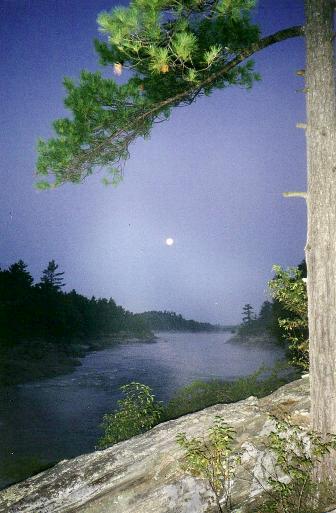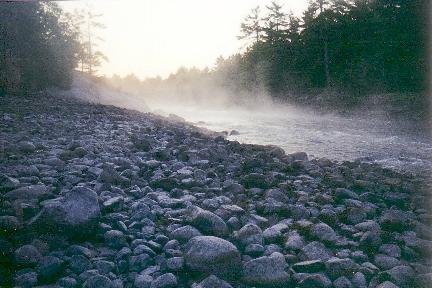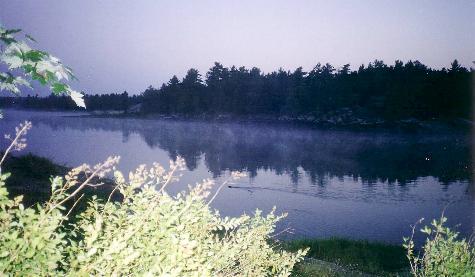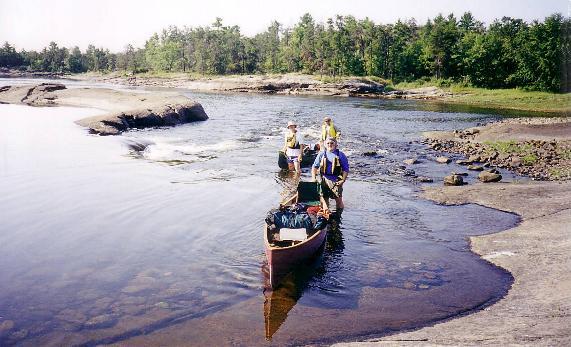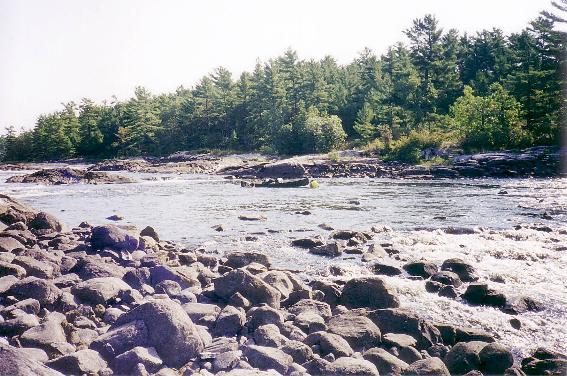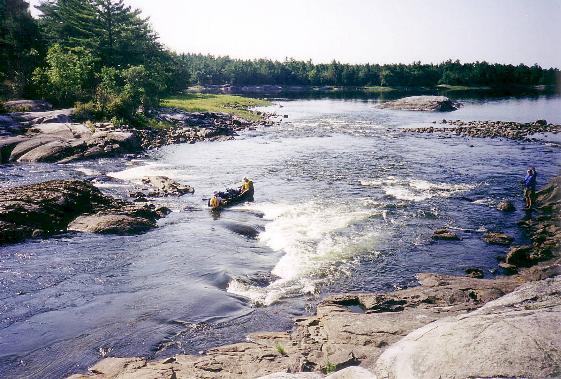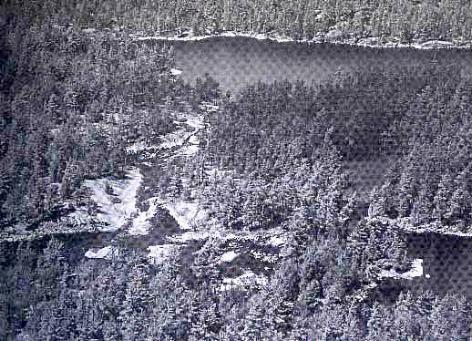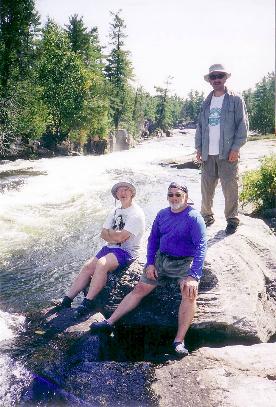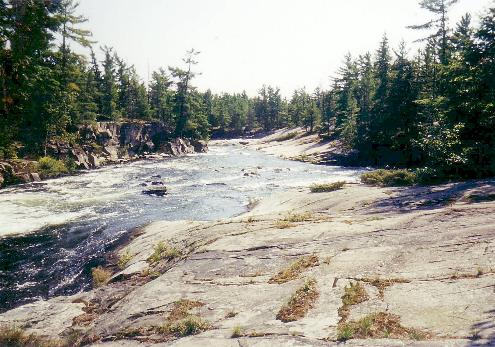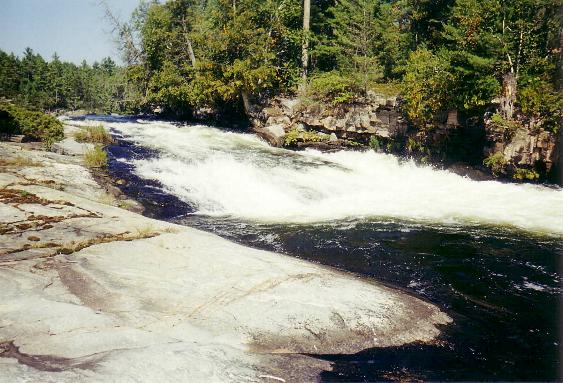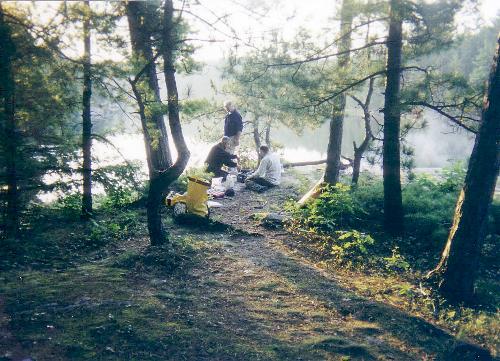Thursday Sept 11 The scoured granite ledge next to the Blue Chute Rapids was testament of passing glaciers and the formation of the Canadian Shield. Mist steamed off tumbling rapids and beyond into the westerly flowing French River. At 6 am, Norm H captured on camera the silhouette of a wide-topped pine, with its twisted arms thrown out against the sky in the face of a setting bright moon a post card photo, the reward for early rising!
Descending Moon below Blue Chute Rapids at 6 am
Sunrise above Blue Chute Rapids at 6:30 am
A beaver swimming in the French River A beaver swam above Blue Chute Rapids, a v-shape current following behind him. Upon hearing the sound of the camera, he slapped his tail hard on the still water and dove beneath the surface, soon to re-appear further upstream. Returning to the rock ledge, Norm H observed a bird gliding over the rapids from within the Main Channel and aiming directly towards him, curiously turning its head and glaring as it passed in slow motion; so close that every feathered detail could be easily seen it was an osprey. Standing in awe, Norm H watched as, still gliding, the osprey circled over the mouth of the chute and returned, taking another passing glance before diving downward to just a few feet above the rapids and out of sight downstream. The flapping wings of a dozen ducks could be heard as they flew upstream over the rapids, through the chute and then veered left up the river as the sun slowly crept over the treeline beyond the chute with mist still billowing off the rapids. It was a stimulating start to a new day, truly appreciated and to be remembered for a long time. While having breakfast, Norm H confessed to having a "senior moment" when he discovered that during the night, a chipmunk had managed to get into his backpack and steal every peanut from his bag of trail mix, leaving only the raisins and dried fruit a difficult penalty for forgetting to put the treats in the food bag the previous night. We hauled the canoes over a boulder-filled channel entrance, L4 P50, next to the escarpment where the two Norms paddled the canoes solo to a landing where the equipment was stowed. While waiting for Norm R to load up his canoe, Norm H ferried his canoe across the river where he was met by the same osprey once again gliding so delicately and serenely overhead perhaps passing by to say "adieu" and to wish us a safe journey. While backtracking towards Double Rapids and looking into the depths of the clear water, a foot and a half long bass was spotted swimming idly against the current it gingerly veered away as the canoe passed. We put in on the left of Double Rapids and walked our canoes up the shallow, rock-laden ledge without much difficulty - a gentle current drifted between our next chutes and rapids, making upstream travel possible without much strain.
Backtracking the tamer Double Rapids At Big Pine Rapids, Norm H and Wayne decided that the current was too swift to walk or line their canoe over the two sets of drops. They commenced to follow the L5P40 portage, but were interrupted when they noticed that Norm R and John were attempting to track their canoe towards the first "drop" the surging power of the current slowed their progress and they were having difficulty advancing. Norm R held onto a short bowline, but the force of the current caused the bow to dip downward to the point of allowing water to flow over the gunwales. He let go of the rope and John was able to snag his canoe before having to bail out the water. Norm H returned to his canoe to retrieve his emergency throw line, fortunately his first throw landed into the canoe. With rope attached, the canoe was released, veering into and across the current as it was pulled towards shore. Drenched, but not disheartened, we all portaged this set of rapids.
Norm R & John trying to negotiate Big Pine Rapids
Norm R & John trying to negotiate Big Pine Rapids At Little Pine Rapids, the force of the water was too great to allow a canoe to be lined up this steep drop; however, John took up the challenge. Fishermen on the opposite bank stopped to watch this event in progress. In their attempt, Wayne held onto the bowline while Norm R and John attached themselves to the sides of the canoe. Norm H positioned himself downstream with his canoe at the ready. The swift cascading current quickly relieved Wayne of the rope while the other two tried in vain to maintain hold of the canoe. With Johns canoe safely ashore and his withdrawal from the challenge, we undertook the L6P20 portage. At Lochaven Wilderness Lodge, the operator graciously filled our many water bottles with ice and cold water he refused payment, but we left him a tip. John later sent the lodge an e-mail thanking the operator for his hospitality.
Ariel view of Five Fingers Rapids Upon entering the French River Channel, we met a group of excited teenagers in six canoes heading for the rapids. We paddled between widely spaced islands until we reached the fast moving Little French River we could hear the rapids, but could not see their enormity. While unloading the canoe, Wayne slipped and fell backwards upon the rocky shoreline with Norm Hs backpack landing upon him luckily he was not injured. The portage L7P600 around Five Fingers Rapids was a humungous undertaking because the path started with a steep, narrow uphill climb with branches hitting our bodies and equipment and the canoes having to be turned sideways in order to get them between trees. Several paths made it difficult to determine the main trail that would lead us to the highest point and to the top of the rapids for a perfect view of the scenic landscape. Once the portaging was completed, we took another break and swam next to where the Little French River emptied into Five Fingers Rapids.
Top of Five Fingers Rapids
Middle of Five Fingers Rapids
Bottom of Five Fingers Rapids The Little French River is very narrow with rocky shorelines with coniferous forest on either side characteristic of the Canadian Shield. To the right was Okikendawt Island, the First Nation reserve. The cloudless sky with the absence of any wind, held the promise of a hot day. The river was shallow with river grass flowing against us in its current, concealing a large dark shape in the pollen-filled water that caught our eye it was another alligator-shaped log-head left to rest on the riverbed from the logging era. A blue heron took off from it roost and flew across the river towards higher ground. Life along this waterway was abundant and ever changing, confirming that this river system could easily be considered a wildlife sanctuary. After passing the Otter Bay campsites, we decided to settle on a crescent-shaped, oak filled campsite, just before the river bend. During a swim, Wayne came into the water with a five-foot long air-filled green water snake float that was used to hold his bottle of soap a comical moment. The heat of the sun was brutal; still we were able to find the solitude that we craved in the wilderness along this stretch of the river. Wayne drew some dry kindling located next to the campfire and went about lighting a fire there is something to be said about the smoky smell of a newly lit campfire.
Little French River Campsite After supper, we sat on the warm rock ledge on this exquisite campsite, watching the orange colored moon rising over the landscape in the star-filled sky as a backdrop - the planet Mars was now twice as far away from the moon than the previous night. Our surroundings began to brighten as the moon rose in the sky.
Copyright by Norm Hooper, December, 2003 http://canoestories.com/french_river |

